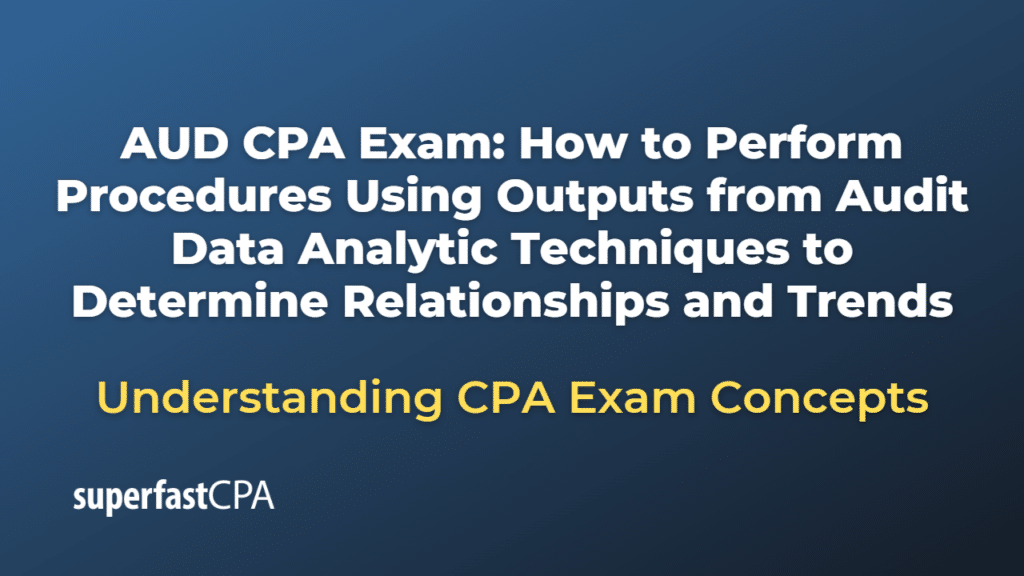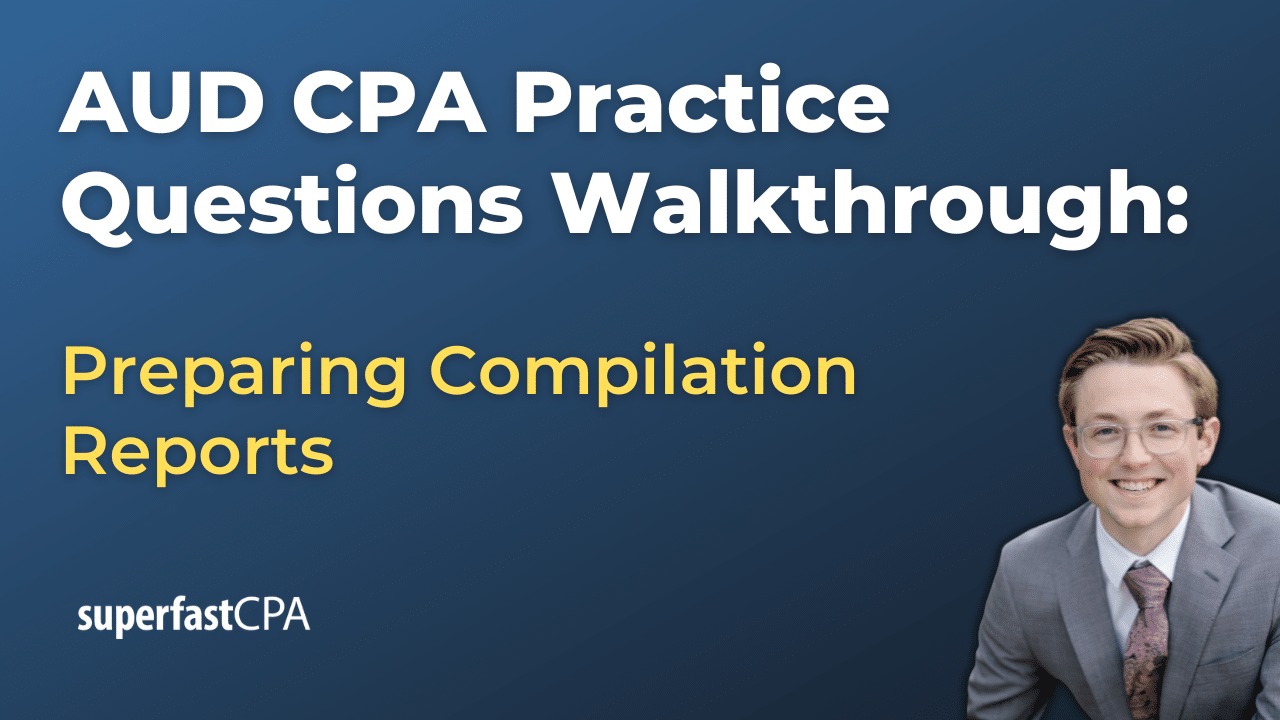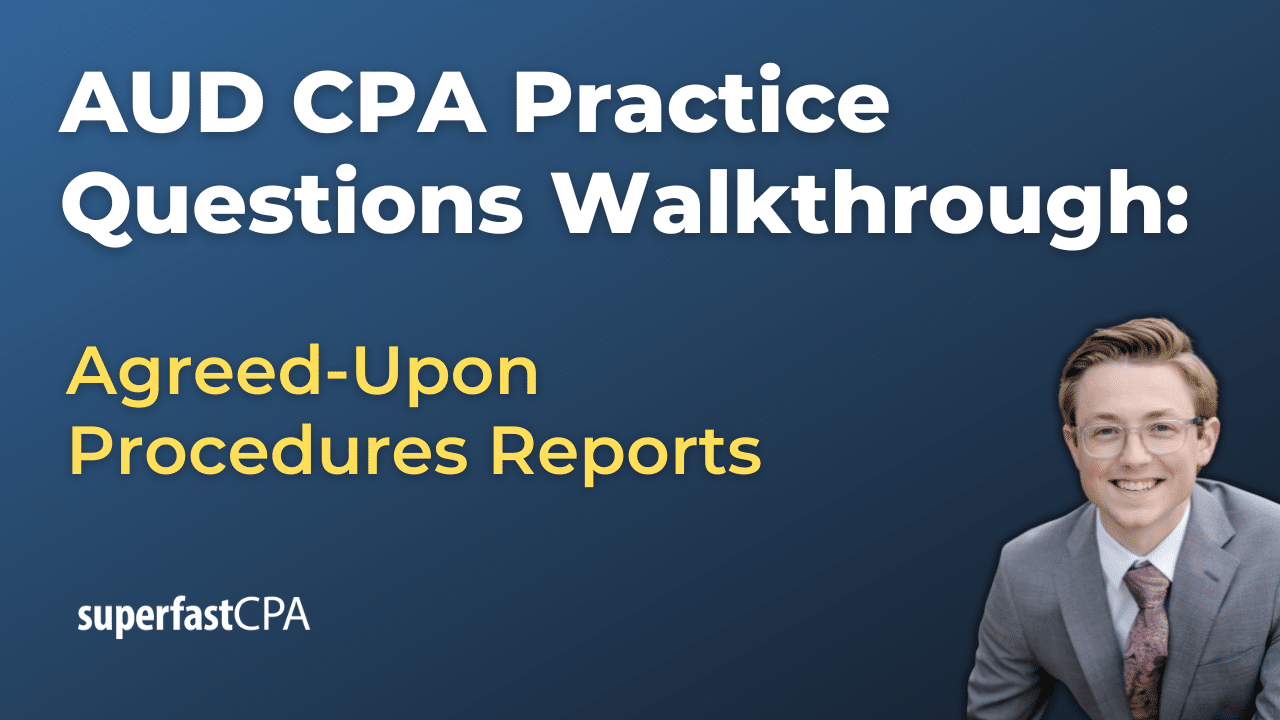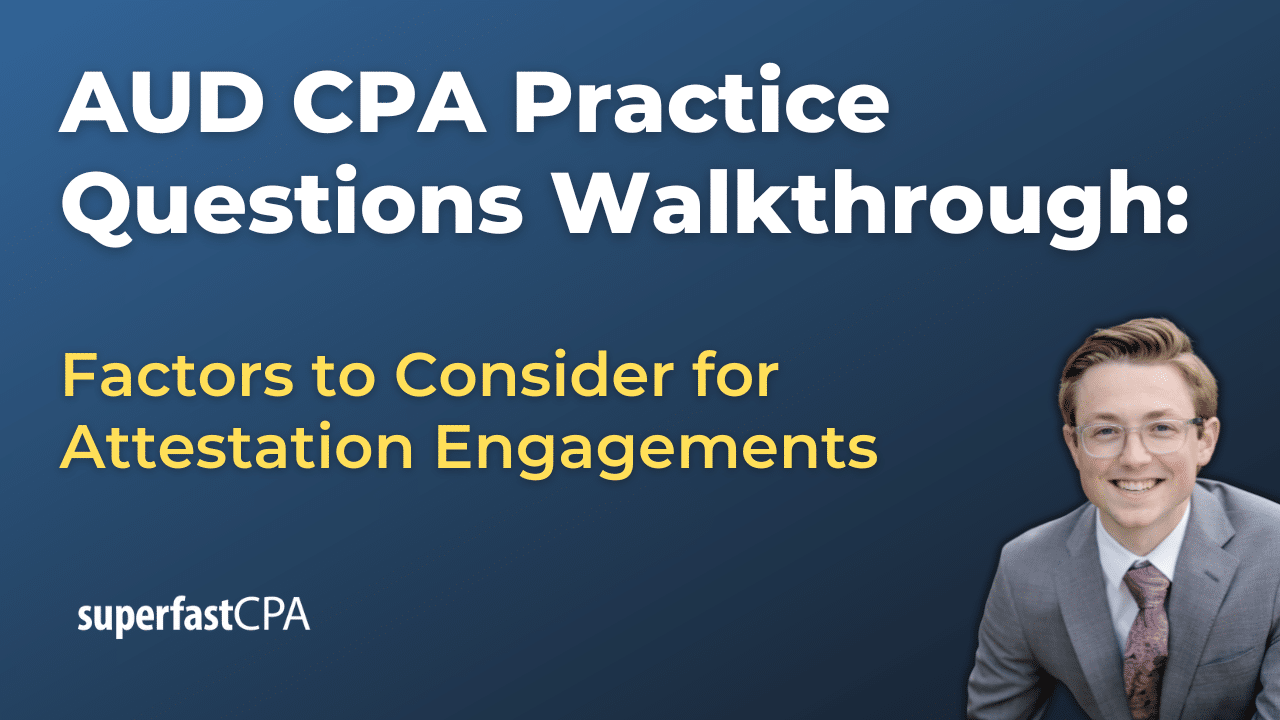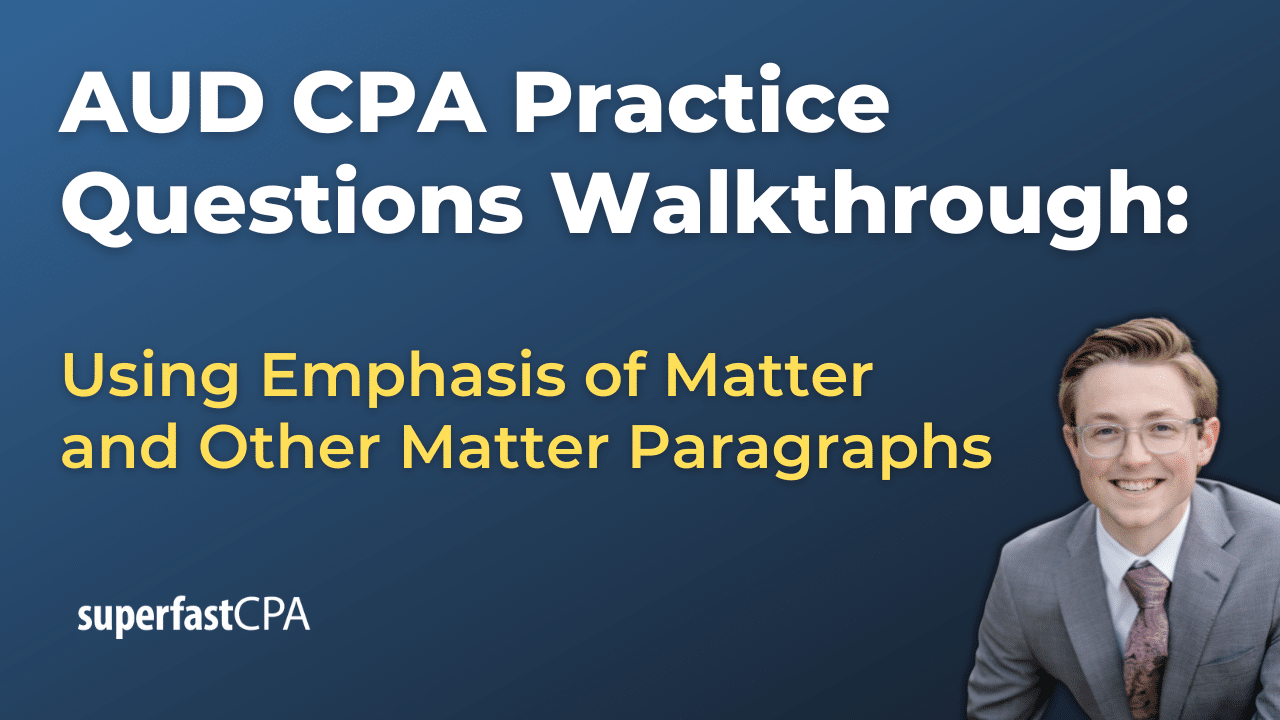Introduction
Purpose of the Article
In this article, we’ll cover how to perform procedures using outputs from audit data analytic techniques to determine relationships and trends. This article is designed to be a comprehensive guide for CPA candidates on the effective use of audit data analytics (ADA) in performing audit procedures. Specifically, it will focus on how ADA can be utilized to analyze relationships and trends among variables, providing auditors with critical insights that enhance their understanding of the financial data under review. With the increasing integration of technology in the auditing profession, mastering ADA techniques is essential for modern auditors. This article will equip CPA candidates with the knowledge and practical skills needed to leverage these tools, ensuring they are well-prepared to apply ADA in real-world audit scenarios.
Importance of Data Analytics in Auditing
Data analytics has revolutionized the auditing process, bringing about a significant shift in how auditors approach their work. Traditionally, auditors relied heavily on sampling and manual analysis to gather evidence and form audit opinions. While effective, these methods often limited the scope of analysis and left room for potential oversight.
With the advent of audit data analytics, auditors can now analyze entire data populations rather than just samples, leading to more accurate and comprehensive audit findings. ADA tools enable auditors to identify patterns, anomalies, and trends that may not be immediately apparent through traditional methods. This capability is particularly valuable in detecting fraud, assessing risks, and ensuring compliance with regulatory requirements.
Furthermore, the use of ADA enhances audit quality by enabling auditors to focus on areas with the highest risk of material misstatement. By providing a deeper and more nuanced understanding of the data, ADA allows auditors to tailor their procedures more effectively, resulting in a more efficient and targeted audit process. As a result, the integration of data analytics into auditing practices is not just a trend but a necessity for maintaining the integrity and reliability of financial reporting in an increasingly complex and data-driven world.
This article will explore the various types of ADA techniques, the interpretation of their outputs, and how these insights can be applied to audit procedures to draw meaningful conclusions. Through this exploration, CPA candidates will gain a solid foundation in the use of data analytics within the context of auditing, preparing them for the challenges and opportunities of modern auditing practices.
Overview of Audit Data Analytic Techniques
Definition of ADA
Audit Data Analytics (ADA) refers to the process of using data analysis tools and techniques to examine financial and non-financial data during an audit. ADA involves the application of various analytical procedures to large data sets, enabling auditors to identify trends, patterns, anomalies, and relationships within the data. The primary purpose of ADA is to enhance the audit process by providing deeper insights into the data, improving the accuracy and efficiency of the audit, and allowing auditors to focus on areas of higher risk.
ADA is increasingly becoming an integral part of the audit process due to the growing availability of big data and advanced analytics tools. By leveraging ADA, auditors can move beyond traditional sampling methods and perform analyses on entire data populations, leading to more comprehensive and reliable audit results. This approach not only increases the precision of the audit but also enables auditors to detect potential issues that may have been overlooked with traditional methods.
Types of Audit Data Analytics
Audit Data Analytics encompasses a variety of techniques that can be used to analyze data in different ways, depending on the audit objectives. The following are the primary types of ADA techniques that auditors commonly use:
Descriptive Analytics
Descriptive analytics is the most basic form of data analytics, and it involves summarizing and organizing data to explain what has happened. In the context of an audit, descriptive analytics helps auditors understand the historical performance and behavior of financial data. This type of analysis typically includes generating reports, charts, and summaries that provide an overview of the data.
For example, an auditor might use descriptive analytics to create a summary report of a company’s sales transactions over the past year, identifying total sales, average transaction values, and seasonal trends. This type of analysis is valuable for establishing a baseline understanding of the data and identifying any obvious anomalies or patterns that warrant further investigation.
Diagnostic Analytics
While descriptive analytics focuses on what happened, diagnostic analytics delves deeper to understand why something happened. This type of analysis involves examining the relationships and correlations between different variables to identify the underlying causes of observed patterns or anomalies.
For instance, an auditor may notice a sudden spike in expenses during a particular period through descriptive analytics. Diagnostic analytics would then be used to investigate the reasons behind this spike, such as changes in supplier pricing, increased production costs, or errors in financial reporting. By understanding the root causes, auditors can provide more meaningful insights and recommendations to their clients.
Predictive Analytics
Predictive analytics goes beyond examining past data to forecast potential future outcomes. Although this type of analysis is more commonly associated with strategic planning and risk management, it also has applications in auditing. Predictive analytics uses statistical models and machine learning algorithms to project future trends based on historical data.
In an audit context, predictive analytics can be used to estimate future financial performance, identify potential risks, and assess the likelihood of certain events occurring. For example, an auditor might use predictive analytics to forecast future cash flows based on past financial data, helping to assess the company’s liquidity and financial stability. While predictive analytics is highly valuable, its application in audit procedures is typically more limited due to the inherent uncertainties in forecasting.
Prescriptive Analytics
Prescriptive analytics is the most advanced form of data analytics, and it involves suggesting possible actions or decisions based on the results of descriptive, diagnostic, and predictive analytics. This type of analysis is particularly useful for decision-making, as it not only provides insights into what might happen but also recommends specific actions to optimize outcomes.
In auditing, prescriptive analytics might be used to suggest adjustments to financial statements or recommend changes in internal controls based on identified risks and trends. For example, if predictive analytics indicates a high risk of inventory obsolescence, prescriptive analytics might recommend specific inventory management practices to mitigate this risk.
While prescriptive analytics offers significant potential, its use in auditing is still emerging. However, as ADA tools continue to evolve, prescriptive analytics is expected to play a more prominent role in guiding audit decisions and enhancing audit quality.
An overview of the key types of audit data analytic techniques, each offering distinct benefits and insights that can enhance the audit process. Understanding and applying these techniques effectively will enable auditors to perform more thorough and insightful analyses, ultimately leading to higher-quality audits.
Understanding Outputs from Audit Data Analytic Techniques
Common Outputs from ADA
Audit Data Analytics (ADA) produces a variety of outputs that help auditors understand the data and draw meaningful conclusions. These outputs typically fall into two main categories: reports and visualizations. Each serves a specific purpose in presenting the results of the data analysis, and auditors must be adept at interpreting these outputs to identify key findings.
Reports
Reports are one of the most common outputs generated by ADA. They present the results of data analysis in a structured format, often including tables, summaries, and detailed findings. Reports are valuable because they provide a comprehensive view of the data and allow auditors to drill down into specific details.
- Tables: Tables are used to organize data into rows and columns, making it easier to compare different data points. For example, a report might include a table listing all transactions above a certain threshold, helping auditors focus on high-risk areas.
- Summaries: Summary reports provide an overview of the data by aggregating key metrics. For instance, an auditor might generate a summary report that highlights total revenues, expenses, and net income for a specific period. These summaries are useful for getting a quick snapshot of the financial situation.
- Detailed Findings: Detailed reports go further by providing in-depth analysis of specific aspects of the data. These might include variance analyses, correlation findings, or other insights derived from ADA. Detailed reports are crucial for understanding the nuances of the data and supporting the auditor’s conclusions.
Visualizations
Visualizations are another powerful output of ADA, transforming complex data sets into easy-to-understand graphical representations. Visualizations help auditors quickly identify patterns, trends, and anomalies that might not be immediately apparent in raw data or reports.
- Graphs: Graphs, such as line graphs, bar charts, and scatter plots, are commonly used to display relationships between variables over time or across categories. For example, a line graph might show sales trends over the past year, highlighting seasonal fluctuations or growth patterns.
- Charts: Pie charts, histograms, and other chart types are effective for illustrating the distribution of data across different categories. For instance, a pie chart could represent the breakdown of expenses by category, allowing auditors to see which areas consume the most resources.
- Heat Maps: Heat maps use color gradients to represent the intensity of data points, making it easier to spot concentrations of activity or areas of concern. In an audit context, a heat map might be used to visualize the frequency of transactions across different departments, highlighting potential areas of risk.
Interpreting ADA Outputs
Interpreting the outputs of ADA is a critical skill for auditors. The ability to read and understand various types of reports and visualizations is essential for identifying key findings and making informed decisions during the audit process. Below are some guidelines for effectively interpreting ADA outputs:
- Identify Key Metrics: Begin by focusing on the key metrics that are most relevant to the audit objectives. These might include financial ratios, trends over time, or correlations between different variables. Understanding which metrics matter most will help you quickly zero in on the most significant findings.
- Look for Patterns and Trends: Use visualizations to identify patterns and trends in the data. For example, a consistent upward trend in expenses over several periods might indicate a need for further investigation. Similarly, spotting an outlier in a scatter plot could reveal an anomaly that warrants closer scrutiny.
- Compare Against Benchmarks: Compare the data against relevant benchmarks, such as industry averages or historical performance. This can help you determine whether the results are within expected ranges or if there are deviations that require explanation.
- Assess the Implications: Once you’ve identified key findings, consider their implications for the audit. For instance, if a heat map reveals high concentrations of transactions in one department, this might indicate a higher risk of error or fraud in that area. Understanding these implications will guide your subsequent audit procedures.
- Document Your Findings: As you interpret the ADA outputs, it’s important to document your findings clearly. This documentation should include not only the key insights but also the rationale behind your interpretations. Clear documentation ensures that your conclusions are well-supported and can be communicated effectively to stakeholders.
By understanding and effectively interpreting the outputs from audit data analytic techniques, auditors can derive valuable insights that enhance the quality and effectiveness of their audits. Whether working with detailed reports or visualizations, the ability to extract meaningful information from ADA outputs is essential for identifying risks, assessing controls, and forming audit opinions.
Procedures for Determining Relationships Among Variables
Correlation Analysis
Definition and Purpose
Correlation analysis is a statistical technique used to measure and understand the strength and direction of the relationship between two or more variables. In an audit context, correlation analysis helps auditors identify whether and how variables are related, which can be crucial for uncovering patterns, detecting anomalies, or assessing risks.
For example, an auditor might use correlation analysis to determine whether there is a relationship between a company’s sales volume and its marketing expenses. If a strong positive correlation is found, it could indicate that increased marketing efforts lead to higher sales, which may be a key consideration when evaluating the company’s financial health.
The purpose of correlation analysis in auditing extends beyond just identifying relationships; it also helps auditors make informed decisions about areas that may require further investigation. By understanding the relationships between variables, auditors can better assess the validity and reliability of financial data, identify potential areas of risk, and focus their audit efforts where they are most needed.
How to Perform Correlation Analysis Using ADA Outputs
Performing correlation analysis using Audit Data Analytics (ADA) involves several steps. Below is a step-by-step guide that outlines the process:
- Identify the Variables to Analyze
- Start by determining which variables you want to analyze for potential correlations. These variables should be relevant to the audit objectives and may include financial metrics like revenue, expenses, asset values, or other operational data. For example, you might want to analyze the relationship between inventory levels and sales revenue.
- Collect and Prepare the Data
- Using ADA tools, collect the necessary data for the selected variables. Ensure that the data is accurate, complete, and properly formatted. Data preparation may involve cleaning the data to remove any errors or inconsistencies, standardizing formats, and ensuring that the data is comparable across the variables being analyzed.
- Run the Correlation Analysis
- Use the ADA software to perform the correlation analysis. Most ADA tools will have built-in functions to calculate correlation coefficients, such as Pearson or Spearman coefficients, depending on the nature of the data. The Pearson correlation coefficient, for example, measures the linear relationship between two continuous variables and ranges from -1 to +1:
- +1 indicates a perfect positive correlation (as one variable increases, the other also increases).
- -1 indicates a perfect negative correlation (as one variable increases, the other decreases).
- 0 indicates no correlation (no relationship between the variables).
- Use the ADA software to perform the correlation analysis. Most ADA tools will have built-in functions to calculate correlation coefficients, such as Pearson or Spearman coefficients, depending on the nature of the data. The Pearson correlation coefficient, for example, measures the linear relationship between two continuous variables and ranges from -1 to +1:
- Interpret the Correlation Coefficient
- Once the analysis is complete, review the correlation coefficients generated by the ADA tool. A strong positive or negative correlation suggests a meaningful relationship between the variables, while a coefficient close to zero indicates little to no relationship. For example, a Pearson correlation coefficient of +0.85 between advertising spend and sales revenue would suggest a strong positive relationship, meaning that higher advertising spend is associated with higher sales.
- Assess the Statistical Significance
- Evaluate the statistical significance of the correlation results to determine whether the observed relationship is likely to be due to chance. ADA tools often provide p-values or confidence intervals along with correlation coefficients. A low p-value (typically less than 0.05) indicates that the correlation is statistically significant, providing more confidence in the relationship observed.
- Visualize the Results
- Visualize the relationship between the variables using scatter plots or other graphical representations. Visualization can help you better understand the nature of the relationship, identify any outliers, and communicate findings more effectively. For example, a scatter plot with a clear upward trend line would visually confirm a positive correlation between two variables.
- Document and Report the Findings
- Document the results of your correlation analysis, including the correlation coefficients, statistical significance, and any visualizations created. In your audit documentation, explain the implications of the relationships identified and how they may impact your audit procedures. For instance, if a strong correlation is found between inventory levels and sales, you might decide to perform additional substantive testing on inventory to ensure its accuracy.
- Determine Next Steps
- Based on the results of the correlation analysis, determine if further analysis or audit procedures are necessary. For example, if an unexpected correlation is identified, such as a strong relationship between unrelated variables, it may prompt further investigation to determine if there are errors or fraud present in the financial data.
By following these steps, auditors can effectively perform correlation analysis using ADA outputs to uncover meaningful relationships between variables. This analysis not only aids in understanding the data but also provides critical insights that can enhance the quality and focus of the audit.
Trend Analysis
Definition and Purpose
Trend analysis is a technique used to identify patterns or tendencies in data over a specific period. In auditing, trend analysis helps auditors recognize significant movements in financial and operational metrics, such as revenue, expenses, or production volumes. By observing how these metrics change over time, auditors can detect consistent patterns, seasonal effects, or anomalies that may indicate underlying issues, such as misstatements, inefficiencies, or potential fraud.
The primary purpose of trend analysis in auditing is to provide a historical perspective on the data, enabling auditors to compare current performance against past trends and expectations. This comparison is vital for assessing whether the financial statements are consistent with previous periods and identifying areas that may require further investigation. For example, if an auditor notices a sudden and unexplained increase in expenses compared to previous years, this might prompt a deeper examination to determine the cause.
Using ADA to Perform Trend Analysis
Audit Data Analytics (ADA) significantly enhances the ability to perform trend analysis by automating the data processing and visualization tasks, allowing auditors to quickly and accurately identify trends in large data sets. Below are the techniques and steps for using ADA to perform trend analysis:
- Define the Time Period for Analysis
- Begin by determining the time frame for the trend analysis. This could range from several months to several years, depending on the nature of the audit and the data available. For example, an auditor may analyze sales trends over the past three years to assess the company’s growth trajectory.
- Collect and Organize the Data
- Use ADA tools to collect the relevant data for the defined time period. Ensure that the data is organized chronologically and that all necessary adjustments have been made for any irregularities, such as changes in accounting policies or one-time events. Organizing the data correctly is crucial for ensuring accurate trend identification.
- Apply ADA Techniques to Identify Trends
- Utilize ADA techniques to identify trends in the data. ADA tools can automatically generate time series plots, moving averages, and other statistical models to highlight trends. For example:
- Time Series Analysis: Plotting the data points over time to observe the general direction of the metrics (upward, downward, or stable).
- Moving Averages: Smoothing out short-term fluctuations to reveal underlying trends. This is particularly useful in identifying long-term trends in volatile data.
- Regression Analysis: Establishing a relationship between time and the variable of interest, allowing for trend projection into the future.
- Utilize ADA techniques to identify trends in the data. ADA tools can automatically generate time series plots, moving averages, and other statistical models to highlight trends. For example:
- Interpret the Trends
- Analyze the visualizations and statistical outputs generated by the ADA tools to interpret the trends. Look for consistent patterns, such as seasonal variations (e.g., higher sales during holidays) or cyclical trends (e.g., increased production at the end of a fiscal year). Additionally, pay attention to any deviations from expected trends, as these may indicate potential issues that need further investigation.
- Compare Against Benchmarks and Expectations
- Compare the identified trends against industry benchmarks, historical performance, and management’s expectations. This comparison helps auditors assess whether the trends are consistent with what would be expected in the given context. For example, if a company’s revenue trend is significantly below industry benchmarks, this may raise concerns about its competitive position or financial health.
- Visualize the Trends
- Use visualizations such as line graphs, bar charts, and trend lines to represent the trends clearly and effectively. Visualization makes it easier to communicate the identified trends to stakeholders and supports the auditor’s analysis with visual evidence. For example, a line graph showing a steady increase in expenses over several quarters can effectively highlight a potential area of concern.
- Document and Report Findings
- Document the findings of the trend analysis, including the identified trends, any anomalies, and the implications for the audit. Explain how the trends align or deviate from expectations and what further audit procedures may be necessary as a result. For instance, if an upward trend in costs is identified without a corresponding increase in revenue, the auditor might recommend a closer examination of cost controls and expense reporting.
- Determine Follow-Up Actions
- Based on the trend analysis, decide on the necessary follow-up actions. This could involve more detailed testing in areas where unusual trends were identified, or it might require discussions with management to understand the reasons behind certain trends. The goal is to ensure that any risks or irregularities highlighted by the trend analysis are adequately addressed in the audit.
Trend analysis is a powerful tool in the auditor’s arsenal, providing insights into the direction and stability of financial and operational metrics over time. By using ADA to perform trend analysis, auditors can quickly identify significant patterns, evaluate their implications, and take appropriate actions to ensure the accuracy and reliability of the financial statements. This proactive approach helps auditors focus their efforts on areas of greatest risk and provides valuable information for decision-making throughout the audit process.
Variance Analysis
Definition and Purpose
Variance analysis is a key analytical procedure used in auditing to compare actual financial results against expected outcomes or budgeted figures. The primary purpose of variance analysis is to identify and understand the reasons behind any deviations between what was planned and what actually occurred. By analyzing these variances, auditors can uncover potential issues such as inefficiencies, errors, or even fraudulent activities.
In the context of an audit, variance analysis is particularly useful for assessing the performance of various financial aspects, such as revenue, expenses, and profitability. For example, if a company’s actual operating expenses significantly exceed the budgeted amount, variance analysis would prompt the auditor to investigate the causes of this discrepancy. Understanding these variances helps auditors assess the accuracy of the financial statements and determine whether further audit procedures are necessary.
Performing Variance Analysis with ADA
Audit Data Analytics (ADA) enhances the process of variance analysis by providing sophisticated tools that can automatically calculate variances and highlight significant deviations. Using ADA, auditors can quickly identify and analyze variances, making the audit process more efficient and thorough. Below are the steps for performing variance analysis using ADA:
- Define the Expected Outcomes
- Start by determining the expected outcomes or benchmarks against which actual results will be compared. These could include budgeted figures, prior period results, industry standards, or management’s forecasts. For example, an auditor might compare the current year’s actual revenue against the budgeted revenue for the same period.
- Collect the Actual Data
- Using ADA tools, gather the actual financial data for the period under review. Ensure that the data is accurate and complete, as any errors in the data collection process could skew the variance analysis results. The actual data might include financial metrics such as sales, expenses, gross margins, or net income.
- Calculate the Variances
- Use ADA software to automatically calculate the variances between the actual results and the expected outcomes. This involves subtracting the expected figures from the actual figures to determine whether the variance is favorable or unfavorable. For instance:
- Favorable Variance: When actual revenue exceeds the budgeted amount or when actual expenses are lower than budgeted.
- Unfavorable Variance: When actual revenue is lower than the budgeted amount or when actual expenses exceed the budget.
- Use ADA software to automatically calculate the variances between the actual results and the expected outcomes. This involves subtracting the expected figures from the actual figures to determine whether the variance is favorable or unfavorable. For instance:
- Analyze the Variances
- Once the variances are calculated, analyze them to determine their significance. ADA tools can help by automatically identifying and flagging variances that exceed a certain threshold, allowing auditors to focus on the most significant discrepancies. For example, a 20% unfavorable variance in production costs may warrant a deeper investigation to understand the cause.
- Visualize the Variances
- Visualize the variances using ADA-generated reports and visualizations such as bar charts, variance tables, or waterfall charts. These visualizations help to clearly display the differences between actual and expected results, making it easier to identify and communicate significant variances. For example, a waterfall chart might show the cumulative impact of various variances on the company’s overall profitability.
- Investigate the Causes of Significant Variances
- For significant variances, conduct further analysis to determine the underlying causes. This might involve reviewing supporting documentation, interviewing management, or performing additional audit procedures. For example, if there is an unfavorable variance in payroll expenses, the auditor might investigate whether there were unexpected overtime costs, hiring of additional staff, or errors in payroll processing.
- Document and Report the Findings
- Document the findings from the variance analysis, including the significant variances identified, their potential causes, and the implications for the audit. This documentation should also include any additional audit procedures performed as a result of the variance analysis. Clear documentation ensures that the rationale for any audit adjustments or recommendations is well-supported and can be communicated effectively to stakeholders.
- Determine Further Audit Actions
- Based on the results of the variance analysis, determine whether further audit actions are required. This might involve extending the scope of testing in areas where significant variances were identified, or it may require discussing the variances with management to obtain explanations and corroborative evidence. The goal is to ensure that all significant variances are adequately addressed and that the financial statements are free from material misstatements.
Variance analysis is a crucial procedure in the audit process, allowing auditors to identify discrepancies between actual and expected results and to understand the reasons behind these differences. By leveraging ADA tools to perform variance analysis, auditors can quickly and accurately spot variances, investigate their causes, and take appropriate actions to ensure the accuracy and reliability of the financial statements. This approach not only enhances the efficiency of the audit but also provides valuable insights that contribute to a more comprehensive and informed audit opinion.
Procedures for Interpreting Results
Evaluating Results from ADA
Significance of Findings
Once Audit Data Analytics (ADA) has been performed, the next critical step is to evaluate the significance of the findings. The significance of identified trends, correlations, or variances is determined by their potential impact on the financial statements and the overall audit objectives. Auditors must carefully assess whether these findings indicate areas of material misstatement, risk, or inefficiency that could influence the audit opinion.
To assess the importance of identified trends or relationships, consider the following factors:
- Magnitude of the Findings: Large variances or strong correlations often carry more significance than smaller ones. For example, a significant positive correlation between revenue and accounts receivable might indicate a risk of overstated revenues if the receivables are not collectible.
- Consistency with Expectations: Determine whether the findings align with management’s expectations, historical performance, or industry benchmarks. Unexpected or unexplained trends may require further investigation to rule out errors, fraud, or other issues.
- Relevance to Audit Objectives: Focus on findings that directly relate to the key audit objectives, such as the accuracy of financial statements or the effectiveness of internal controls. For example, if ADA reveals a trend of increasing expenses without corresponding revenue growth, this might indicate a potential issue with expense recognition or management’s financial strategy.
- Potential for Misstatement: Consider the likelihood that the identified trends or relationships could lead to material misstatements in the financial statements. High-risk areas should be prioritized for further testing and review.
Implications for the Audit
The results of ADA have direct implications for the audit opinion and the audit procedures that follow. Understanding these implications is essential for ensuring that the audit is both thorough and accurate. The key considerations include:
- Adjusting the Audit Approach: Based on the ADA findings, auditors may need to adjust their audit approach, focusing more on areas where significant risks or anomalies have been identified. For example, if a significant variance in inventory levels is detected, additional substantive testing on inventory valuation may be required.
- Impact on Audit Opinion: The significance of ADA findings can affect the audit opinion, particularly if they indicate material misstatements or control deficiencies. Auditors must evaluate whether the findings warrant a qualified opinion, an adverse opinion, or even a disclaimer of opinion in extreme cases.
- Communication with Management and Governance: Significant ADA findings may also necessitate communication with management and those charged with governance. This communication should address any concerns about the reliability of the financial statements, the effectiveness of internal controls, and the potential need for corrective actions.
Documenting Findings
Best Practices for Documentation
Proper documentation of ADA findings is crucial for supporting the audit opinion and ensuring compliance with auditing standards. Clear and comprehensive documentation provides a record of the auditor’s analysis, conclusions, and the rationale behind audit decisions. Best practices for documentation include:
- Detailing the Analysis Process: Document the ADA procedures performed, including the data sources used, the specific analyses conducted, and any tools or software employed. This transparency ensures that the audit process can be replicated or reviewed if necessary.
- Recording Key Findings and Conclusions: Clearly document all significant findings from the ADA, along with the auditor’s conclusions. For example, if a strong correlation between marketing expenses and sales was identified, document the nature of this relationship and its potential implications for revenue recognition.
- Explaining the Implications for Audit Procedures: Describe how the ADA findings influenced the audit approach. For instance, if a trend analysis indicated a significant risk of revenue misstatement, document the additional substantive procedures performed to address this risk.
- Maintaining Audit Trail: Ensure that all documentation is organized and linked to the corresponding audit workpapers, creating a clear audit trail that supports the audit opinion and findings.
Communicating Results to Management
Effectively communicating ADA findings to management and stakeholders is essential for ensuring that the audit results are understood and acted upon. Consider the following strategies for presenting your findings:
- Use Clear and Concise Language: When communicating with management, avoid overly technical language. Instead, present the findings in clear, straightforward terms that non-auditors can easily understand.
- Visualize Key Findings: Use visualizations such as charts, graphs, and tables to present complex data in an accessible format. For example, a bar chart showing significant variances between budgeted and actual expenses can quickly convey areas of concern to management.
- Provide Context and Recommendations: Along with presenting the findings, provide context by explaining the potential risks or implications of the findings. Where appropriate, offer recommendations for corrective actions or further investigation. For example, if a variance analysis reveals significant overspending in a particular department, recommend a review of expense controls and budgeting practices.
- Encourage Feedback and Discussion: Engage management in a discussion about the findings, encouraging them to ask questions and provide their perspectives. This dialogue can help clarify any issues and foster a collaborative approach to addressing the audit findings.
By carefully evaluating the results from ADA and effectively documenting and communicating those findings, auditors can ensure that their audit is both comprehensive and actionable. These steps are essential for providing a reliable audit opinion and supporting the overall integrity of the financial statements.
Case Study Examples
Example 1: Performing Correlation Analysis Using ADA in Revenue Audits
Scenario: An auditor is tasked with assessing the reliability of revenue recognition practices for a mid-sized retail company. The company has experienced fluctuating sales over the past year, and there are concerns about whether the reported revenues accurately reflect the company’s financial performance.
Objective: To determine if there is a significant correlation between the company’s marketing expenditures and its revenue figures, which could indicate whether increased marketing efforts are directly influencing sales.
Procedure:
- Identify Variables: The auditor selects total monthly revenue and total monthly marketing expenditures as the variables for correlation analysis.
- Collect Data: Using ADA tools, the auditor gathers data on revenue and marketing expenditures for each month of the fiscal year.
- Run Correlation Analysis: The auditor uses the ADA software to calculate the Pearson correlation coefficient between the two variables.
- Interpret Results: The analysis reveals a Pearson correlation coefficient of +0.75, indicating a strong positive correlation between marketing expenditures and revenue. This suggests that as the company increases its marketing efforts, revenue tends to increase as well.
- Implications: The auditor concludes that the revenue figures appear to be influenced by marketing activities, which supports the legitimacy of the reported revenue. However, the auditor recommends additional testing to ensure that revenue recognition aligns with accounting standards, particularly around timing and cut-off.
- Documentation: The auditor documents the correlation analysis process, the findings, and the impact on the audit approach, including any additional procedures performed to verify revenue recognition practices.
Example 2: Conducting Trend Analysis in Expense Audits
Scenario: A manufacturing company has reported steadily increasing operating expenses over the past several quarters, raising concerns among stakeholders about cost management. The auditor is tasked with examining the trend in operating expenses to identify any unusual patterns or areas of concern.
Objective: To identify and analyze trends in operating expenses over the past year to determine if the increases are consistent with the company’s operational activities or if they signal potential issues.
Procedure:
- Define Time Period: The auditor selects a 12-month period for trend analysis, covering the current fiscal year.
- Collect Data: Using ADA tools, the auditor gathers monthly data on operating expenses, including costs for raw materials, labor, utilities, and overhead.
- Apply Trend Analysis: The ADA software is used to create a time series plot of operating expenses, along with moving averages to smooth out short-term fluctuations.
- Interpret Results: The trend analysis reveals a consistent upward trend in operating expenses, with a particularly sharp increase in the last quarter. The auditor notes that the increase corresponds with a period of higher production volume, but the rate of expense growth exceeds the rate of revenue growth.
- Implications: The auditor identifies the sharp increase in expenses as a potential risk area and decides to perform additional testing on expense accounts, particularly focusing on cost controls and the allocation of overhead costs.
- Documentation: The auditor documents the trend analysis, the identified risks, and the additional procedures conducted to ensure that the increased expenses are properly accounted for and that no misstatements exist.
Example 3: Using ADA Outputs for Variance Analysis in Inventory Audits
Scenario: A wholesale distributor has reported significant variances between actual and budgeted inventory levels for several key product lines. The auditor is tasked with investigating these variances to determine whether they are due to errors, inefficiencies, or potential misstatements.
Objective: To perform variance analysis using ADA to identify and investigate the causes of significant discrepancies between actual and budgeted inventory levels.
Procedure:
- Define Expected Outcomes: The auditor gathers the budgeted inventory levels for each product line, as provided by the company’s management.
- Collect Actual Data: The auditor uses ADA tools to extract actual inventory levels from the company’s inventory management system for the same period.
- Calculate Variances: The ADA software automatically calculates the variances between the budgeted and actual inventory levels for each product line.
- Visualize Variances: The auditor generates a bar chart using ADA tools to visually compare the variances across different product lines, highlighting the most significant discrepancies.
- Investigate Causes: The auditor focuses on the product lines with the largest unfavorable variances. Further investigation reveals that these variances are due to discrepancies in inventory counts, which were not properly reconciled during the period-end close process.
- Implications: The auditor identifies the inventory discrepancies as a significant risk area and recommends a detailed review of the company’s inventory count procedures and controls. Additional substantive testing is performed to ensure the accuracy of the inventory balances reported in the financial statements.
- Documentation: The auditor documents the variance analysis process, the identified discrepancies, the causes, and the additional audit procedures performed. The findings are communicated to management with recommendations for improving inventory controls.
These case study examples illustrate how auditors can effectively use ADA to perform correlation analysis, trend analysis, and variance analysis in different audit scenarios. By leveraging ADA tools, auditors can gain deeper insights into financial data, identify potential risks, and take appropriate actions to ensure the accuracy and reliability of the financial statements.
Challenges and Best Practices in Using ADA
Common Challenges
As powerful as Audit Data Analytics (ADA) can be in enhancing the audit process, it is not without its challenges. Understanding these challenges is essential for auditors to effectively mitigate risks and ensure that their analyses are both accurate and meaningful.
Data Quality Issues
One of the most significant challenges in using ADA is ensuring the quality of the data being analyzed. Data quality issues can arise from several factors, including incomplete data, inaccurate entries, and inconsistencies in data formatting. These issues can severely impact the reliability of ADA results, leading to potential misinterpretations and incorrect audit conclusions.
- Incomplete Data: Missing data points can skew analysis, particularly in trend or correlation analyses. For example, if key transactions are not recorded or data from certain periods is missing, the resulting analysis will not accurately reflect the true financial situation.
- Inaccurate Data: Errors in data entry, such as incorrect amounts or misclassified transactions, can lead to misleading ADA outputs. Inaccurate data can create false trends, correlations, or variances, which might lead auditors to incorrect conclusions.
- Data Consistency: Inconsistent data formats, such as differing date formats or variations in how financial figures are recorded, can cause problems in ADA processing. For instance, if some financial figures are recorded with rounding while others are not, this can lead to discrepancies in analysis.
Interpretation Errors
Another common challenge with ADA is the risk of interpretation errors. These errors occur when auditors misread the outputs generated by ADA tools or draw incorrect conclusions from the data. Interpretation errors can arise due to a lack of familiarity with the analytics tools, misapplication of statistical concepts, or an over-reliance on ADA outputs without considering the broader context.
- Misreading Outputs: ADA tools can generate complex outputs, including statistical models and visualizations, which may be difficult to interpret correctly without proper training. For example, misunderstanding the significance of a correlation coefficient could lead to incorrect conclusions about the relationship between variables.
- Drawing Incorrect Conclusions: Even when the data is accurate and the ADA tools are functioning correctly, there is still a risk of drawing incorrect conclusions. This can happen if auditors fail to consider external factors, such as changes in market conditions, that might explain the observed trends or variances.
Best Practices
To overcome these challenges and maximize the effectiveness of ADA, auditors should follow best practices that focus on ensuring data integrity and continuously improving their skills and knowledge.
Ensuring Data Integrity
Ensuring the integrity of the data used in ADA is crucial for obtaining reliable and meaningful results. Auditors can take several steps to ensure that the data they analyze is accurate, complete, and consistent.
- Data Validation: Implement procedures to validate the data before it is used in ADA. This might include cross-checking data with source documents, reconciling discrepancies, and verifying that all relevant data has been captured. Automated data validation checks can also be incorporated into ADA tools to flag potential issues.
- Data Cleansing: Regularly perform data cleansing activities to correct any inaccuracies, remove duplicates, and standardize data formats. This step helps to ensure that the data is ready for analysis and reduces the risk of errors.
- Audit Trails: Maintain a clear audit trail that documents the source of the data, any modifications made during the data preparation process, and the steps taken to ensure its accuracy. This documentation is critical for ensuring transparency and supporting the auditor’s conclusions.
Continuous Learning and Adaptation
The field of audit data analytics is rapidly evolving, with new tools, techniques, and best practices emerging regularly. To stay effective, auditors must commit to continuous learning and adaptation.
- Training and Education: Regularly participate in training programs and workshops that focus on the latest ADA tools and techniques. This will help auditors stay up-to-date with new features and capabilities that can enhance their audit processes.
- Experimentation and Practice: Encourage a culture of experimentation where auditors are allowed to explore new ADA tools and techniques in a controlled environment. Practicing with different tools and scenarios helps auditors become more comfortable with ADA and reduces the risk of interpretation errors.
- Peer Collaboration: Engage with peers and colleagues to share insights, experiences, and best practices in using ADA. Collaborative learning can lead to the discovery of new approaches and solutions to common challenges.
- Stay Informed on Industry Trends: Keep abreast of industry trends and advancements in data analytics. Subscribing to relevant publications, attending industry conferences, and participating in professional networks can help auditors stay informed and ahead of the curve.
By acknowledging and addressing the common challenges associated with ADA and adhering to best practices, auditors can significantly improve the reliability and effectiveness of their data analyses. Ensuring data integrity and committing to continuous learning are key to successfully leveraging ADA in the audit process, ultimately leading to more accurate audit outcomes and informed decision-making.
Conclusion
Recap of Key Points
In this article, we have explored the essential role that Audit Data Analytics (ADA) plays in modern auditing. We began by understanding the definition and types of ADA techniques, including descriptive, diagnostic, predictive, and prescriptive analytics. We then delved into the practical application of ADA in audit procedures, focusing on how to perform correlation analysis, trend analysis, and variance analysis to uncover relationships, patterns, and discrepancies in financial data.
We also addressed the importance of accurately interpreting ADA outputs and documenting findings in a way that supports the audit opinion and enhances communication with stakeholders. Additionally, we discussed the common challenges auditors face when using ADA, such as data quality issues and interpretation errors, and provided best practices to overcome these challenges, including ensuring data integrity and committing to continuous learning.
The Future of ADA in Auditing
As the audit profession continues to evolve, the role of ADA will only grow in significance. Advances in technology, including artificial intelligence and machine learning, are poised to further enhance the capabilities of ADA tools, allowing auditors to perform more sophisticated analyses with greater efficiency and accuracy. The ability to analyze vast amounts of data in real time and identify potential risks before they become material issues will transform how audits are conducted, making them more proactive and predictive.
Moreover, the integration of ADA into audit methodologies is likely to expand, with more firms adopting these techniques as a standard practice. This evolution will require auditors to continuously update their skills and knowledge, staying informed about the latest developments in data analytics and how they can be applied to the audit process. As such, mastering ADA will be crucial for auditors who want to remain competitive and effective in their roles.
Encouragement for Candidates
For CPA candidates preparing to enter the profession, mastering Audit Data Analytics is not just an option—it is a necessity. The ability to use ADA effectively will set you apart in the field, enabling you to deliver more insightful, accurate, and value-added audits. While the learning curve may seem steep, the rewards are substantial. By investing time in understanding ADA techniques, practicing their application, and staying current with emerging trends, you will position yourself as a forward-thinking auditor capable of navigating the complexities of today’s data-driven environment.
Remember, the journey to mastering ADA is a continuous one. Embrace the challenges, seek out opportunities for learning, and be open to experimentation and collaboration. The skills you develop now will not only help you pass the CPA exam but also equip you with the tools needed for a successful and fulfilling career in auditing. As the profession evolves, so too will your role as an auditor—becoming more dynamic, innovative, and integral to the financial reporting process. Keep pushing forward, and you will find yourself well-prepared to meet the demands of the future audit landscape.

